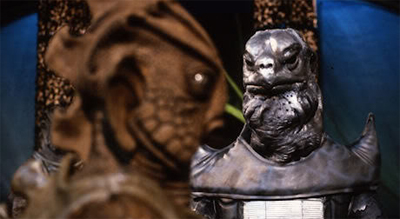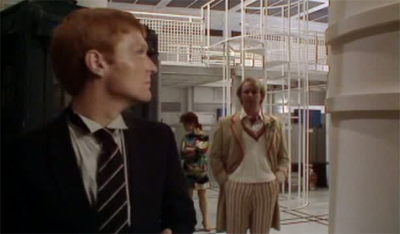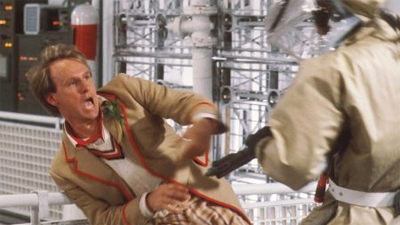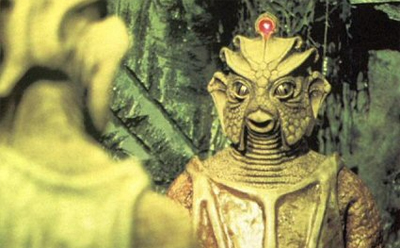To celebrate the fiftieth anniversary of the longest-running science-fiction show in the world, I’ll be taking weekly looks at some of my own personal favourite stories and arcs, from the old and new series, with a view to encapsulating the sublime, the clever and the fiendishly odd of the BBC’s Doctor Who.
Warriors of the Deep originally aired in 1984.
“Release the Myrka.”
– three words to create dread in even the toughest Doctor Who fan
I’ve always been somewhat less fond of Johnny Byrne’s Doctor Who than most fans. I can never, for example, understand the high esteem generally reserved for The Keeper of Traken (although it is a better story than Logopolis), and I really disliked Arc of Infinity. So I suspect some of the problems with Warriors of the Deepwere quite fundamental. However, there’s also a sense that those flaws were only exaggerated by a combination of other factors, including a low budget, a tight schedule and a script editor who believed an adventure’s pathos could be measured by its bodycount.
To be fair, there are some interesting ideas here. I’ve always argued that Peter Davison’s Doctor was an inherently tragic figure, a character who could have resolved most of the problems he encountered with ease, if only somebody would listen to him. So harking back to two of the more tragic Jon Pertwee serials – The Silurians and The Sea Devils, both built around the fact that humanity was incapable or unwilling to seek a peaceful solution to a large-scale problem – seemed like a perfect fit. And, to an extent, it is. That closing shot of the final episode is iconic, as Davison’s Doctor looks over the dead bodies on the base, and proclaims, truly broken, “There should have been another way.”
And Davison, to be fair, gives it socks. When confronted with a serial that looked to be a disaster, Jon Pertwee would often set himself on autopilot and Tom Baker would turn his performance to eleven, but Davison is genuinely trying. Even though the entire serial is nonsense and the script is building up this conflict as one with an ideological depth it very clearly lacks, Davison sells the audience on the Doctor’s frustration and sorrow at how things unfolded. He delivers his lines like a comsumate professional, and pitches everything just right, from his pointless moral lambasting of the crew to the way he utters the name of “the Myrka” with a tired and defeated attitude, like he’s talking about that mate who always runs out during his round, or that one relative you want to avoid at a wedding, who’ll talk your ear off given the chance.
There are cool concepts here. I like the idea of a missile control that requires a human mental interface in order to work, even if it does ultimately end up getting tied up in a pointless sabotage subplot that seems to have very little to do with anything else going on in the adventure. A lot of people are quite tough on the seabase, mocking the decision to make everything white and shiny. I like the set, and I’d argue it looks good – though it does shake a bit when Turlough helps Preston into an air vent, which sorta ruins the effect. This era of the show had consciously moved away from the dark and gothic stylings of the Hinchcliffe era, and I think the sea base is an impressive example of how that aesthetic could possibly work – it looks perfectly sterile and impersonal, much like the strange Cold-War-esque conflict we’re watching, played out between two political entities that we (intentionally) know nothing about.
The lighting might be a bit much, but the truth is that the Mykra would have looked terrible in any form that isn’t an audio play (in fact, it’s telling that the creature has the most impact beforewe see it burst through some lame foam doors. Dimming the lights or even shooting in black and white couldn’t have made the costume look any more threatening – and we still would have had to worry about the stupid kung-fu fight. Because it isn’t an effective Pertwee homage without some gratuitous kung-fu. I can actually believe that the ill-conceived fight sequence is the footage used by Michael Grade to justify sending the show on hiatus the following year.
That said, I do kinda like the way that the Silurians and Sea Devils look. I’ve gone on-record stating my opinion that the costumes in The Silurians look bad and while they don’t look great here, they do look much better. The Sea Devils, on the other hand, actually look really well with their strange mock-samurai sort of thing going on. They’re not the best monsters Doctor Who has ever produced, but they aren’t the worst by a long shot and I’d argue they improved the classic appearances. So those are the list of elements to Warriors of the Deep that I sorta liked – and in most cases, it was very heavily qualified.
The simple fact is that Warriors of the Deeploses a lot of the wonderful ambiguity that made the first two adventures featuring these alien races such a joy. I suspect it’s an intentional move on the part of Byrne, and I give it credit, but there’s a definite cynicism about the whole thing. The humans and the reptile races were both equal parts innocent and guilty in the tragedies that unfolded during the Pertwee era, with both parties in both disagreements acting with clear and understandable motives, and (mostly) in relatively good faith until circumstances forced them to do otherwise. Here, however, it seems that both races are just equally guilty.
There’s nothing to like about the Silurians and the Sea Devils here, and no understanding. They launch an unprovoked and unannounced attack on the sea base in the hopes of committing genocide. Ichtar attempts to justify the actions of the reptiles citing the two adventures seen years earlier, protesting, “Twice we offered the hand of friendship to these ape-descended primitives, and twice we were treacherously attacked, our people slaughtered. It will not happen again.” That discounts the fact that every human being involved in those incidents is probably dead by this stage, and ignores the fact that Ichtar has made no effort to pursue a peaceful solution, and refuses to listen to the Doctor. Any character using the words “final solution” to justify their plans is hardly sympathetic.
The tragedy of The Silurians was that both sides wanted peace, and both sought to benefit from it – it was only circumstance and a few conspirators that sabotaged that idealistic dream and rendered it an impossible fantasy. Here, the Silurians and Sea Devils are murderous genocidal villains, who have repeatedly demonstrated that they will not listen to reason. Johnny Byrne takes two of the series’ more fascinating races and reduces them to two-dimensional villains.
The only thing that hints at a level of tragedy is the suggestion that the humans are no better. Set a century after it aired, the serial shows a mankind that is still blindly pursuing conflict and war, causing environmental damage, and without any regard for the world around them. “Little seems to have changed since my time,” Tegan suggests. “Progress doesn’t seem to have solved anything.” We don’t find anything out about the warring factions, but we don’t need to – the point is clear: humans are inherently self-destructive and short-sighted, with a passion for conflict. It doesn’t matter who or why, but we’ll always wind up plotting to kill each other.
So the script suggests moral equality between the human soldiers and the reptile invaders, but it’s far more cynical than the original stories. The outlook is almost nihilistic. While the possibility of peace narrowly escaped our grasp in The Silurians and The Sea Devils, it’s outright impossible here. That seems to be the entire point of the script. It’s a grim and dark point, one that doesn’t really suit the tone of the show, and it’s handled rather clumsily, but it is there. Part of me wonders if the eighties were really that grim, where the cynical outlook of The Silurians and The Sea Devilsneeded to be rendered even darker.
The problem is that the serial then expects us to care. The Doctor spends the serial defending the attacking Silurians, which seems a bit much. “They could have blown this base apart,” he warns the crew. Then he adds, “They certainly have enough reason to.” Dude, it’s an unprovoked attack – you’re a pacifist, you’re not meant to condone it! “All they ever wanted to do was live in peace,” the Doctor insists, as the bodies start to pile up. It’s at this point I start to worry the Doctor’s becoming delusional.
After a soldier suggests using a biological weapon to defend the base against the attacking genocidal reptile force, the Doctor stubbornly exclaims, “I sometimes wonder why I like the people of this miserable planet so much. The Silurians and Sea Devils are noble races. They have skills and talents you pathetic humans can only dream about.” This is after he has tried to reason with them, and afterthey’ve explained their plans for genocide. The crew didn’t do anything to provoke this attack.
By the way, the repeated use of the terms “Silurian” and “Sea Devil” do bug me. I don’t mind the odd continuity gaffe to tell a good story. For example, I don’t trouble myself wondering why the Daleks from The Daleks are so different from every other Dalek serial (requiring static electricity and radiation to live). However, when The Sea Devils went out of the way to point out that not only was the term “Silurian” made up by the humans, but also inaccurate, it seems ridiculous that the production team missed it. This was a point where the show’s continuity was becoming too insular for its own good, but it’s especially frustrating because it could even keep its own facts straight.
I do like this TARDIS crew, and I especially like the fact that Turlough seems to have the right idea about how to respond to the massive mess they’ve found themselves in, suggesting, “Back to the TARDIS!” When this doesn’t get quite the response he was hoping for, he ponders, “What is it about Earth people that makes them think a futile gesture is a noble one?”Of course, it kinda misses the point that there are very few noble gestures made over the course of the serial. It’s just one big bloodbath.
So the serial begins Davison’s final year much as it would go on – lots and lots of death. All but one guest character (who just seems to disappear) is dead by the time the Doctor packs it in and goes on his way, And the audience is left wondering what the point of it all was. I’m a fan of the Davison era, and even I can’t defend it. Ah well… perhaps it was time for Davison to bow out gracefully.
If it’s any consolation, I may just know how to stop it.
When I want your help, I’ll ask for it.
– the Doctor and Vorshak set the tone for the year
Filed under: Television | Tagged: bbc, Doctor (Doctor Who), doctor who, DoctorWho, Johnny Byrne, Jon Pertwee, Keeper of Traken, Peter Davison, Sea Devils, The Silurians, Warriors of the Deep |




























Thanks for this review. Warriors of the Deep is one of the few Doctor Who episodes that I haven’t watched. I’ve never been much of a Fifth Doctor fan. I’ll get to it eventually as I’m undertaking my first marathon – 50 Years in 50 Weeks. You can check out my blog at http://doctorwhomindrobber.wordpress.com/
I am a huge Fifth Doctor fan. I think he’s my favourite of the classic era Doctors.
Thanks for the link there, and good luck to you on your marathon!